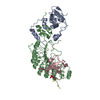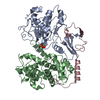[English] 日本語
 Yorodumi
Yorodumi- PDB-8bzo: Cryo-EM structure of CDK2-CyclinA in complex with p27 from the SC... -
+ Open data
Open data
- Basic information
Basic information
| Entry | Database: PDB / ID: 8bzo | ||||||
|---|---|---|---|---|---|---|---|
| Title | Cryo-EM structure of CDK2-CyclinA in complex with p27 from the SCFSKP2 E3 ligase Complex | ||||||
 Components Components |
| ||||||
 Keywords Keywords | CELL CYCLE / cyclin-dependent kinase / signalling / ubiquitination | ||||||
| Function / homology |  Function and homology information Function and homology informationPhosphorylation of proteins involved in the G2/M transition by Cyclin A:Cdc2 complexes / cyclin A2-CDK1 complex / cell cycle G1/S phase transition / cellular response to luteinizing hormone stimulus / mitotic cell cycle phase transition / Transcription of E2F targets under negative control by p107 (RBL1) and p130 (RBL2) in complex with HDAC1 / cyclin-dependent protein serine/threonine kinase inhibitor activity / cellular response to leptin stimulus / male pronucleus / female pronucleus ...Phosphorylation of proteins involved in the G2/M transition by Cyclin A:Cdc2 complexes / cyclin A2-CDK1 complex / cell cycle G1/S phase transition / cellular response to luteinizing hormone stimulus / mitotic cell cycle phase transition / Transcription of E2F targets under negative control by p107 (RBL1) and p130 (RBL2) in complex with HDAC1 / cyclin-dependent protein serine/threonine kinase inhibitor activity / cellular response to leptin stimulus / male pronucleus / female pronucleus / cellular response to cocaine / response to glucagon / cyclin-dependent protein serine/threonine kinase regulator activity / cellular response to insulin-like growth factor stimulus / positive regulation of DNA biosynthetic process / cochlea development / cyclin A1-CDK2 complex / cyclin E2-CDK2 complex / cyclin E1-CDK2 complex / cellular response to platelet-derived growth factor stimulus / cyclin A2-CDK2 complex / positive regulation of DNA-templated DNA replication initiation / G2 Phase / cyclin-dependent protein kinase activity / Y chromosome / Phosphorylation of proteins involved in G1/S transition by active Cyclin E:Cdk2 complexes / positive regulation of heterochromatin formation / p53-Dependent G1 DNA Damage Response / X chromosome / PTK6 Regulates Cell Cycle / regulation of DNA replication / regulation of anaphase-promoting complex-dependent catabolic process / Defective binding of RB1 mutants to E2F1,(E2F2, E2F3) / centriole replication / Regulation of APC/C activators between G1/S and early anaphase / centrosome duplication / Telomere Extension By Telomerase / G0 and Early G1 / negative regulation of mitotic cell cycle / Activation of the pre-replicative complex / cellular response to nitric oxide / cyclin-dependent protein kinase holoenzyme complex / cyclin-dependent kinase / animal organ regeneration / cyclin-dependent protein serine/threonine kinase activity / TP53 Regulates Transcription of Genes Involved in G1 Cell Cycle Arrest / Activation of ATR in response to replication stress / Cyclin E associated events during G1/S transition / Cyclin A/B1/B2 associated events during G2/M transition / Cajal body / Cyclin A:Cdk2-associated events at S phase entry / condensed chromosome / mitotic G1 DNA damage checkpoint signaling / regulation of mitotic cell cycle / regulation of G2/M transition of mitotic cell cycle / cyclin binding / post-translational protein modification / : / meiotic cell cycle / positive regulation of DNA replication / male germ cell nucleus / cellular response to estradiol stimulus / Cdc20:Phospho-APC/C mediated degradation of Cyclin A / potassium ion transport / DNA Damage/Telomere Stress Induced Senescence / CDK-mediated phosphorylation and removal of Cdc6 / SCF(Skp2)-mediated degradation of p27/p21 / Meiotic recombination / Orc1 removal from chromatin / G1/S transition of mitotic cell cycle / Transcriptional regulation of granulopoiesis / G2/M transition of mitotic cell cycle / Cyclin D associated events in G1 / cellular senescence / positive regulation of fibroblast proliferation / Regulation of TP53 Degradation / nuclear envelope / Factors involved in megakaryocyte development and platelet production / Processing of DNA double-strand break ends / protein-folding chaperone binding / cellular response to hypoxia / Senescence-Associated Secretory Phenotype (SASP) / regulation of gene expression / peptidyl-serine phosphorylation / DNA replication / Regulation of TP53 Activity through Phosphorylation / transcription regulator complex / Ras protein signal transduction / chromosome, telomeric region / Ub-specific processing proteases / endosome / chromatin remodeling / negative regulation of cell population proliferation / protein domain specific binding / cell division / protein phosphorylation / DNA repair / protein serine kinase activity / protein serine/threonine kinase activity / DNA-templated transcription Similarity search - Function | ||||||
| Biological species |  Homo sapiens (human) Homo sapiens (human) | ||||||
| Method | ELECTRON MICROSCOPY / single particle reconstruction / cryo EM / Resolution: 3.5 Å | ||||||
 Authors Authors | Rowland, R.J. / Salamina, M. / Endicott, J.A. / Noble, M.E. | ||||||
| Funding support |  United Kingdom, 1items United Kingdom, 1items
| ||||||
 Citation Citation |  Journal: Sci Rep / Year: 2023 Journal: Sci Rep / Year: 2023Title: Cryo-EM structure of SKP1-SKP2-CKS1 in complex with CDK2-cyclin A-p27KIP1. Authors: Rhianna J Rowland / Richard Heath / Daniel Maskell / Rebecca F Thompson / Neil A Ranson / James N Blaza / Jane A Endicott / Martin E M Noble / Marco Salamina /  Abstract: p27KIP1 (cyclin-dependent kinase inhibitor 1B, p27) is a member of the CIP/KIP family of CDK (cyclin dependent kinase) regulators that inhibit cell cycle CDKs. p27 phosphorylation by CDK1/2, signals ...p27KIP1 (cyclin-dependent kinase inhibitor 1B, p27) is a member of the CIP/KIP family of CDK (cyclin dependent kinase) regulators that inhibit cell cycle CDKs. p27 phosphorylation by CDK1/2, signals its recruitment to the SCF (S-phase kinase associated protein 1 (SKP1)-cullin-SKP2) E3 ubiquitin ligase complex for proteasomal degradation. The nature of p27 binding to SKP2 and CKS1 was revealed by the SKP1-SKP2-CKS1-p27 phosphopeptide crystal structure. Subsequently, a model for the hexameric CDK2-cyclin A-CKS1-p27-SKP1-SKP2 complex was proposed by overlaying an independently determined CDK2-cyclin A-p27 structure. Here we describe the experimentally determined structure of the isolated CDK2-cyclin A-CKS1-p27-SKP1-SKP2 complex at 3.4 Å global resolution using cryogenic electron microscopy. This structure supports previous analysis in which p27 was found to be structurally dynamic, transitioning from disordered to nascent secondary structure on target binding. We employed 3D variability analysis to further explore the conformational space of the hexameric complex and uncovered a previously unidentified hinge motion centred on CKS1. This flexibility gives rise to open and closed conformations of the hexameric complex that we propose may contribute to p27 regulation by facilitating recognition with SCF. This 3D variability analysis further informed particle subtraction and local refinement approaches to enhance the local resolution of the complex. | ||||||
| History |
|
- Structure visualization
Structure visualization
| Structure viewer | Molecule:  Molmil Molmil Jmol/JSmol Jmol/JSmol |
|---|
- Downloads & links
Downloads & links
- Download
Download
| PDBx/mmCIF format |  8bzo.cif.gz 8bzo.cif.gz | 121.2 KB | Display |  PDBx/mmCIF format PDBx/mmCIF format |
|---|---|---|---|---|
| PDB format |  pdb8bzo.ent.gz pdb8bzo.ent.gz | 92.1 KB | Display |  PDB format PDB format |
| PDBx/mmJSON format |  8bzo.json.gz 8bzo.json.gz | Tree view |  PDBx/mmJSON format PDBx/mmJSON format | |
| Others |  Other downloads Other downloads |
-Validation report
| Summary document |  8bzo_validation.pdf.gz 8bzo_validation.pdf.gz | 1.3 MB | Display |  wwPDB validaton report wwPDB validaton report |
|---|---|---|---|---|
| Full document |  8bzo_full_validation.pdf.gz 8bzo_full_validation.pdf.gz | 1.4 MB | Display | |
| Data in XML |  8bzo_validation.xml.gz 8bzo_validation.xml.gz | 36 KB | Display | |
| Data in CIF |  8bzo_validation.cif.gz 8bzo_validation.cif.gz | 51.4 KB | Display | |
| Arichive directory |  https://data.pdbj.org/pub/pdb/validation_reports/bz/8bzo https://data.pdbj.org/pub/pdb/validation_reports/bz/8bzo ftp://data.pdbj.org/pub/pdb/validation_reports/bz/8bzo ftp://data.pdbj.org/pub/pdb/validation_reports/bz/8bzo | HTTPS FTP |
-Related structure data
| Related structure data |  16344MC  8byaC  8bylC C: citing same article ( M: map data used to model this data |
|---|---|
| Similar structure data | Similarity search - Function & homology  F&H Search F&H Search |
- Links
Links
- Assembly
Assembly
| Deposited unit | 
|
|---|---|
| 1 |
|
- Components
Components
| #1: Protein | Mass: 33943.312 Da / Num. of mol.: 1 Source method: isolated from a genetically manipulated source Details: Thr160 phosphorylated CDK2 / Source: (gene. exp.)  Homo sapiens (human) / Gene: CDK2, CDKN2 / Production host: Homo sapiens (human) / Gene: CDK2, CDKN2 / Production host:  |
|---|---|
| #2: Protein | Mass: 48609.574 Da / Num. of mol.: 1 Source method: isolated from a genetically manipulated source Source: (gene. exp.)  Homo sapiens (human) / Gene: CCNA2, CCN1, CCNA / Production host: Homo sapiens (human) / Gene: CCNA2, CCN1, CCNA / Production host:  |
| #3: Protein | Mass: 17678.531 Da / Num. of mol.: 1 Source method: isolated from a genetically manipulated source Source: (gene. exp.)  Homo sapiens (human) / Gene: p27 kip1 / Production host: Homo sapiens (human) / Gene: p27 kip1 / Production host:  |
| Has ligand of interest | N |
-Experimental details
-Experiment
| Experiment | Method: ELECTRON MICROSCOPY |
|---|---|
| EM experiment | Aggregation state: PARTICLE / 3D reconstruction method: single particle reconstruction |
- Sample preparation
Sample preparation
| Component | Name: Complex of CDK2-CyclinA-p27(kip1)from the SCFSKP2 E3 ligase complex Type: COMPLEX / Entity ID: all / Source: RECOMBINANT |
|---|---|
| Molecular weight | Value: 0.074 MDa / Experimental value: NO |
| Source (natural) | Organism:  Homo sapiens (human) Homo sapiens (human) |
| Source (recombinant) | Organism:  |
| Buffer solution | pH: 7.8 |
| Specimen | Conc.: 0.2 mg/ml / Embedding applied: NO / Shadowing applied: NO / Staining applied: NO / Vitrification applied: YES |
| Specimen support | Grid material: COPPER / Grid mesh size: 400 divisions/in. / Grid type: Quantifoil R1.2/1.3 |
| Vitrification | Instrument: FEI VITROBOT MARK IV / Cryogen name: ETHANE / Humidity: 95 % / Chamber temperature: 278.15 K |
- Electron microscopy imaging
Electron microscopy imaging
| Experimental equipment |  Model: Titan Krios / Image courtesy: FEI Company |
|---|---|
| Microscopy | Model: FEI TITAN KRIOS |
| Electron gun | Electron source:  FIELD EMISSION GUN / Accelerating voltage: 300 kV / Illumination mode: FLOOD BEAM FIELD EMISSION GUN / Accelerating voltage: 300 kV / Illumination mode: FLOOD BEAM |
| Electron lens | Mode: BRIGHT FIELD / Nominal magnification: 130000 X / Nominal defocus max: 3000 nm / Nominal defocus min: 1000 nm / Cs: 2.7 mm / C2 aperture diameter: 70 µm |
| Specimen holder | Cryogen: NITROGEN |
| Image recording | Average exposure time: 9 sec. / Electron dose: 65 e/Å2 / Film or detector model: GATAN K2 SUMMIT (4k x 4k) |
- Processing
Processing
| EM software |
| ||||||||||||||||||||||||||||||||||||||||
|---|---|---|---|---|---|---|---|---|---|---|---|---|---|---|---|---|---|---|---|---|---|---|---|---|---|---|---|---|---|---|---|---|---|---|---|---|---|---|---|---|---|
| CTF correction | Type: PHASE FLIPPING AND AMPLITUDE CORRECTION | ||||||||||||||||||||||||||||||||||||||||
| Particle selection | Num. of particles selected: 1110356 | ||||||||||||||||||||||||||||||||||||||||
| Symmetry | Point symmetry: C1 (asymmetric) | ||||||||||||||||||||||||||||||||||||||||
| 3D reconstruction | Resolution: 3.5 Å / Resolution method: FSC 0.143 CUT-OFF / Num. of particles: 136325 / Symmetry type: POINT | ||||||||||||||||||||||||||||||||||||||||
| Atomic model building | B value: 121 / Protocol: RIGID BODY FIT / Space: REAL Details: Initial fitting was performed in chimera followed by real space refinement in Phenix | ||||||||||||||||||||||||||||||||||||||||
| Refine LS restraints |
|
 Movie
Movie Controller
Controller




 PDBj
PDBj










